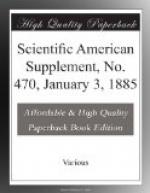Dr. H.A. Mott recently delivered a lecture before the New York Academy of Sciences, in Columbia College, on the Fallacy of the Present Theory of Sound.
He commenced his lecture by stating that “the object of science was not to find out what we like or what we dislike; the object of science was truth.” He then said that, as Galileo stated a hypothesis should be judged by the weight of facts and the force of mathematical deductions, he claimed the theory of sound should be so examined, and not allowed to exist as a true theory simply because it is sustained by a long line of scientific names; as too many theories had been overthrown to warrant the acceptance of any one authority unless they had been thoroughly tested. Dr. Mott stated that Dr. Wilford Hall was the first to attack the theory of sound and show its fallaciousness, and that many other scientists besides himself had agreed with Dr. Hall in his arguments and had advanced additional arguments and experiments to establish this fact. Dr. Mott first gave a very elaborate and still at the same time condensed statement of the current theory of sound as propounded by such men as Helmholtz, Tyndall, Lord Rayleigh, Mayer, Rood, Sir Wm. Thomson, and others, and closed this section of the paper with the remarks made by Tyndall: “Assuredly no question of science ever stood so much in need of revision as this of the transmission of sound through the atmosphere. Slowly but surely we mastered the question, and the further we advance, the more plainly it appeared that our reputed knowledge regarding it was erroneous from beginning to end.”
Dr. Mott then took up the other side of the question, and treated the same under the following heads:
1. Agitation of the air. 2. Mobility of the atmosphere. 3. Resonance. 4. Heat and velocity of the supposed sound waves. 5. Decrease in loudness of sound. 6. The physical strength of the locust. 7. The barometric theory of Sir Wm. Thomson. 8. Elasticity and density of the air. 9. Interference and beats. 10. The membrana tympani and the corti arches.
Under the first head Dr. Mott stated that all experiments and photographs made to establish the existence of sound waves simply referred to the necessary agitation of the air accompanying any disturbance, such as would of necessity be produced by a vibrating body, and had nothing to do directly with sound. He stated that in the Edison telephone, sound was converted directly into electricity without vibrating any diaphragm at all, as attested to by Edison himself. Speaking of the mobility of the air, he said the particles were free to slip around and not practically be pushed at all, and that the greatest distance a steam whistle could affect the air would not exceed 30 feet, and the waves would not travel more than 4 or 5 feet a second, while sound travels 1,120 feet a second. Under heat and velocity of sound waves, Dr. Mott stated that Newton found by calculating the exact relative density and elasticity of air that sound should travel only 916 feet a second, while it was known to travel 1,120 feet a second.




